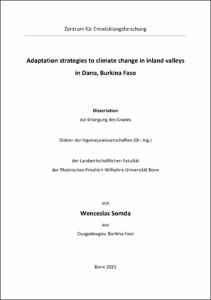Adaptation strategies to climate change in inland valleys in Dano, Burkina Faso

Adaptation strategies to climate change in inland valleys in Dano, Burkina Faso

| dc.contributor.advisor | Bogardi, Janos J. | |
| dc.contributor.author | Somda, Wenceslas | |
| dc.date.accessioned | 2021-06-16T11:37:03Z | |
| dc.date.available | 2021-06-16T11:37:03Z | |
| dc.date.issued | 16.06.2021 | |
| dc.identifier.uri | https://hdl.handle.net/20.500.11811/9168 | |
| dc.description.abstract | The agriculture in Sub Saharan Africa at many locations is under-performing and lags behind the other continents in terms of yields as well as productivity. The recent progression in the produced quantities is mainly due to an increase in the croplands, which has major effects on the environment. In West Africa, climate variability is one of the causes of low yields as most of the cropping systems are rainfed and the region has one of the most variable precipitation pattern in the World. Climate change, on the other hand, brings more uncertainties to the weather and can be considered as a threat, knowing the severe problem of food insecurity in the continent. The strategies towards a more performing and resilient agriculture comprise the use of inland valleys for intensive agriculture. The use of irrigation and water control infrastructures inside inland valleys is assessed in this study to apprehend the potential for agriculture inside inland valleys, under current and probable future climatic conditions.
Four inland valleys located within the Dano basin have been investigated, in the South West of Burkina Faso, two with reservoirs and irrigated schemes, one with contour bunds, and the last with drainage canals. The four schemes have been equipped to monitor the different water fluxes such as the runoff from the upstream catchment, the water level inside the reservoirs, the shallow groundwater levels with piezometers in the uplands and the bottomlands, and the drainage. The performance inside the four schemes revealed important losses by infiltration and evaporation inside the reservoir-based schemes and high drainage ratio for the others. The water quality showed very low mineral contents for nitrates, nitrites, orthophosphates, and potassium, due to the low fertilizer input, for both the surface water and the groundwater. The climate records from the city of Dano has been examined to understand the precipitation pattern and the future climate trends with statistical tools. In one out of six and half years, the monthly rainfalls decline by around 80% in June and October corresponding to the beginning and the end of the rainy season, while the seasonal sum from June to October is reduced by 45%. The anomalies detected on eleven models under the scenarios RCP4.5 and RCP8.5 revealed high uncertainties on the precipitation amounts, while the rainy days and the temperatures are expected to respectively decrease from -4% to -35% and increase from +1.3° to +6.8° C. The effects of selected climate scenarios have been evaluated for rainfed rice in the four schemes with a crop growth model. The AquaCrop model was applied to simulate the effect of the expected increase in temperature and CO2-level and decrease in precipitation on crop yield and biomass. Results show a rise of yield and water productivity due to higher CO2-level, whereas rising temperature is lowering these indicators. The effects of water stress are variable and influenced by the soil types and the shallow groundwater levels. The adaptation strategies to climate variability and change are possible only with better storage systems and with improved management. The comparison of the four valleys shows more profits for the reservoir-based schemes in terms of outputs and level of organization of the farmers for the maintenance of the infrastructures, despite the losses by evaporation and infiltration. The other schemes, although benefitting from low investment for their construction, and disposing of flexibility in their use and expansion, lack the required control over the water inflows and outflows, and fail to be productive. The use of shallow groundwater has not been assessed in this study in terms of potential for supplementing the cropping systems in the future and may switch the attention on their exploitation for agriculture in the future. | en |
| dc.language.iso | eng | |
| dc.rights | In Copyright | |
| dc.rights.uri | http://rightsstatements.org/vocab/InC/1.0/ | |
| dc.subject | Water management | |
| dc.subject | Irrigation | |
| dc.subject | Climate change | |
| dc.subject.ddc | 620 Ingenieurwissenschaften und Maschinenbau | |
| dc.title | Adaptation strategies to climate change in inland valleys in Dano, Burkina Faso | |
| dc.type | Dissertation oder Habilitation | |
| dc.publisher.name | Universitäts- und Landesbibliothek Bonn | |
| dc.publisher.location | Bonn | |
| dc.rights.accessRights | openAccess | |
| dc.identifier.urn | https://nbn-resolving.org/urn:nbn:de:hbz:5-62610 | |
| ulbbn.pubtype | Erstveröffentlichung | |
| ulbbnediss.affiliation.name | Rheinische Friedrich-Wilhelms-Universität Bonn | |
| ulbbnediss.affiliation.location | Bonn | |
| ulbbnediss.thesis.level | Dissertation | |
| ulbbnediss.dissID | 6261 | |
| ulbbnediss.date.accepted | 23.04.2021 | |
| ulbbnediss.institute | Zentrale wissenschaftliche Einrichtungen : Zentrum für Entwicklungsforschung (ZEF) | |
| ulbbnediss.fakultaet | Landwirtschaftliche Fakultät | |
| dc.contributor.coReferee | Becker, Mathias | |
| ulbbnediss.contributor.gnd | 1238917011 |
Dateien zu dieser Ressource
Das Dokument erscheint in:
-
E-Dissertationen (1013)




